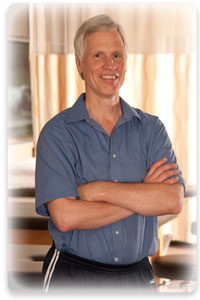Structural Integration Provides Long-Term Benefits
 Rolfing Structural Integration works to reorganize our physical structure. This structure is determined by the events that have shaped our lives. These include our birth, how we learned to move and walk, illnesses, accidents, societal obligations, emotional events, repetitive motions and others. Over time, as these events leave their accumulated marks, our body becomes limited in its ability to adapt as well as in its range of options.
Rolfing Structural Integration works to reorganize our physical structure. This structure is determined by the events that have shaped our lives. These include our birth, how we learned to move and walk, illnesses, accidents, societal obligations, emotional events, repetitive motions and others. Over time, as these events leave their accumulated marks, our body becomes limited in its ability to adapt as well as in its range of options.
But why does this happen? The answer lies in how our body compensates for these forces.
Dr. Rolf described fascia as the “organ of structure”. It is a tissue that covers and shapes everything in our body. It is organized as a web of interconnected layers that start just under the skin, and continue into our body’s deepest cells. It uniquely combines the qualities of being tough and durable with being flexible. Within limts, it also is malleable allowing us to grow and adapt, and it is here the trouble begins.
When the integrity of an area of the body becomes compromised through injury, repetitive use, etc., the fascia in that area thickens and attaches to nearby areas creating rigidity. While this helps stabilize that site, it is at the cost of our ability to move as a whole. So while we think that the sprained ankle or the twisted knee has fully healed, the truth is the fascia still retains some rigidity. Economy of movement is sacrificed as other areas, such as nearby joints, are forced to take up an unnatural load. Besides wearing down these nearby areas, energy is lost as efficient movement is forced to give way.
Over our lives, these compensations build up until an overwhelmed area gives out. We have a harder time recovering. We tire more easily and we don’t have the range of motion that we should. Gravity is experienced a heavy force pulling us down. As this sometimes unconscious burden of physical stress builds, so too does our emotional burden. This reduces our creative energies and causes us to experience life with less enjoyment.
Rolf Structural Integration reverses this process. During the series of 10 sessions, directional pressure is used to release the fascial contrictions and unwind the compensations. Appropriate movement is reintroduced throughout the entire body. Balance is elicited from side to side, top to bottom, front to back, and from the superficial tissue to the deep tissue. As these contrictions are removed, clients often report a greater sense of ease or lightness. With the physical bindings gone, outgrown emotional patterning can also give way.
A person that is intregrated is better able to adapt. With more energy available, healing is able to take place. The 10-series is not a cure. Rather, it is a way of setting up the body so its restorative properties are free to bring back a forgotten level of health.
Jim Arkison has been in practice for over 20 years, and members of our staff who have had the opportunity to receive Jim’s work are thrilled with the results. His expertise has been a valuable resouce for many of our clients. Ask to be introduced to him. You will not regret it.
How Much Does Rolfing Cost?
Unfortunately, Rolfing is not a covered benefit of insurance so this requires a cash commitment: $110 for an hour and a half session with a requirement to commit to 10 sessions over 3-4 months. A patient needs to understand that they will only have 10 sessions in a year’s time, as once the patient completes 10 sessions they will not need further sessions for at least a year, and then only 2-3 sessions per year. Investing in Rolfing can be compared to investing in our environment—a cost up front is savings in the long run.
